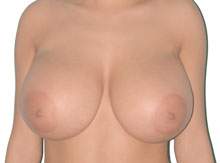Gigantomastia or macromastia
Image: Macromastia in a young woman
In medicine, too large breasts are called macromastia or gigantomastia.
Gigantomastia, i.e. overly large breasts, belongs to the same category as micromastia (breasts that are too small) to breast malformations.
But where is the threshold at which one can speak of macromastia or breast malformation? This limit varies from woman to woman. It depends on body size and stature.
In some textbooks, the assessment of macromastia is based on the number of grams. A breast weight of over 600g (per side) is often referred to as macromastia, and over 1500g as gigantomastia.
It is plausible that these values are often very irrational. Imagine a petite woman with a height of 150 cm and a weight of 50 kg. In such cases, macromastia can be assumed even with a breast weight of 450g.
What are the causes?
In the vast majority of cases, there is no explanation for macromastia other than heredity. Nevertheless, some special features should not go unmentioned:
- If you are overweight, the fat content of the breasts increases, which can lead to macromastia.
- In some cases, large breasts are also caused by hormonal changes during puberty (pubertal macromastia) and can normalize again afterwards.
- One particular form is macromastia during pregnancy (gravid macromastia). Hormonal changes during pregnancy induce breast gland growth, which does not regress after pregnancy.
What complaints are made about macromastia?
For many of those affected, having excessively large breasts means an enormous amount of suffering. Psychologically, many of these women feel that other people stare at them because of their excess size. This often leads to an unconsciously curved posture of the thoracic spine with a postural defect in order to conceal the breasts.
- Patients also often complain of back and neck pain. In this respect, around 80% of women feel relief immediately after breast reduction.
- The weight causes pulling pain due to bra constrictions on the shoulders.
- Macerations (intertrigo) and fungal infections (mycoses) occur more frequently in the underbust fold, especially at higher temperatures in summer.
- The poor posture caused by the weight can lead to signs of wear and tear in the thoracic and cervical spine.
- Sporting activities are hardly possible.
- Finding the right size is often a major challenge.
It is a misconception that gigantomastia can be treated conservatively. Physical measures (physiotherapy) and psychotherapy do not address the actual problem, the high weight of the breast.
This can only be achieved by a breast reduction. Even with pre-existing cervical spine syndrome or thoracic spine pain syndrome, breast reduction can reduce the weight and thus also alleviate the symptoms and reduce or delay further wear and tear.
In men, the term gynecomastia is used instead of macromastia. This is generally not a congenital malformation.
You may also be interested in the articles Breast malformations, Breast reduction and Things to know about cost coverage by health insurance.


